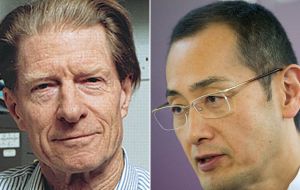MercoPress. South Atlantic News Agency
Nobel in Medicine for stem-cells reprogramming that could some day repair damaged organs
 Cambridge Professor Gurdon and his peer Yamanaka from Kyoto University
Cambridge Professor Gurdon and his peer Yamanaka from Kyoto University Scientists from Britain and Japan shared the Nobel Prize in Medicine for the discovery that adult cells can be reprogrammed back into stem cells which can turn into any kind of tissue and may one day repair damaged organs.
John Gurdon, 79, of the Gurdon Institute in Cambridge, Britain and Shinya Yamanaka, 50, of Kyoto University in Japan, discovered ways to create tissue that would act like embryonic cells, without the need to harvest embryos. They share the 1.2 million dollars prize equally.
“These groundbreaking discoveries have completely changed our view of the development and specialisation of cells,” the Nobel Assembly at Stockholm's Karolinska Institute said in a statement.
The big hope for stem cells is that they can be used to replace damaged tissues in everything from spinal cord injuries to Parkinson's disease. All of the tissue in the body starts as stem cells, before developing into mature skin, blood, nerves, muscle and bone.
Scientists once thought it was impossible to turn adult tissue back into stem cells, which meant that new stem cells could only be created by harvesting embryos. But Yamanaka and Gurdon showed that development can be reversed, turning adult cells back into cells that behave like embryos.
With “induced pluripotency stem cells”, or iPS cells, ordinary skin or blood cells from adults are transformed back into stem cells which doctors hope will be able to repair damaged organs without being rejected by the immune system.
There are concerns, however, that iPS cells could grow out of control and develop into tumours.
“The eventual aim is to provide replacement cells of all kinds,” Gurdon's Institute explains on its website.
“We would like to be able to find a way of obtaining spare heart or brain cells from skin or blood cells. The important point is that the replacement cells need to be from the same individual, to avoid problems of rejection and hence of the need for immuno-suppression.”
Gurdon discovered in 1962 that the specialisation of cells could be reversed. In what the prize committee called “a classic experiment”, he replaced the immature cell nucleus in an egg cell of a frog with the nucleus from a mature intestinal cell.
This modified egg cell developed into a normal tadpole, proving that the mature cell still had all the information needed to develop all cells in the frog.
More than 40 years later, in 2006, Yamanaka discovered how intact mature cells in mice could be reprogrammed to become stem cells by adding just a few genes.
“Thanks to these two scientists, we know now that development is not strictly a one-way street,” said Thomas Perlmann, Nobel Committee member and professor of Molecular Development Biology at the Karolinska Institute.
”There is lot of promise and excitement, and difficult disorders such as neurodegenerative disorders, like perhaps Alzheimer's and, more likely, Parkinson's disease, are very interesting targets”.




Top Comments
Disclaimer & comment rules-

Read all commentsTeamwork!
Oct 09th, 2012 - 04:34 am 0Commenting for this story is now closed.
If you have a Facebook account, become a fan and comment on our Facebook Page!